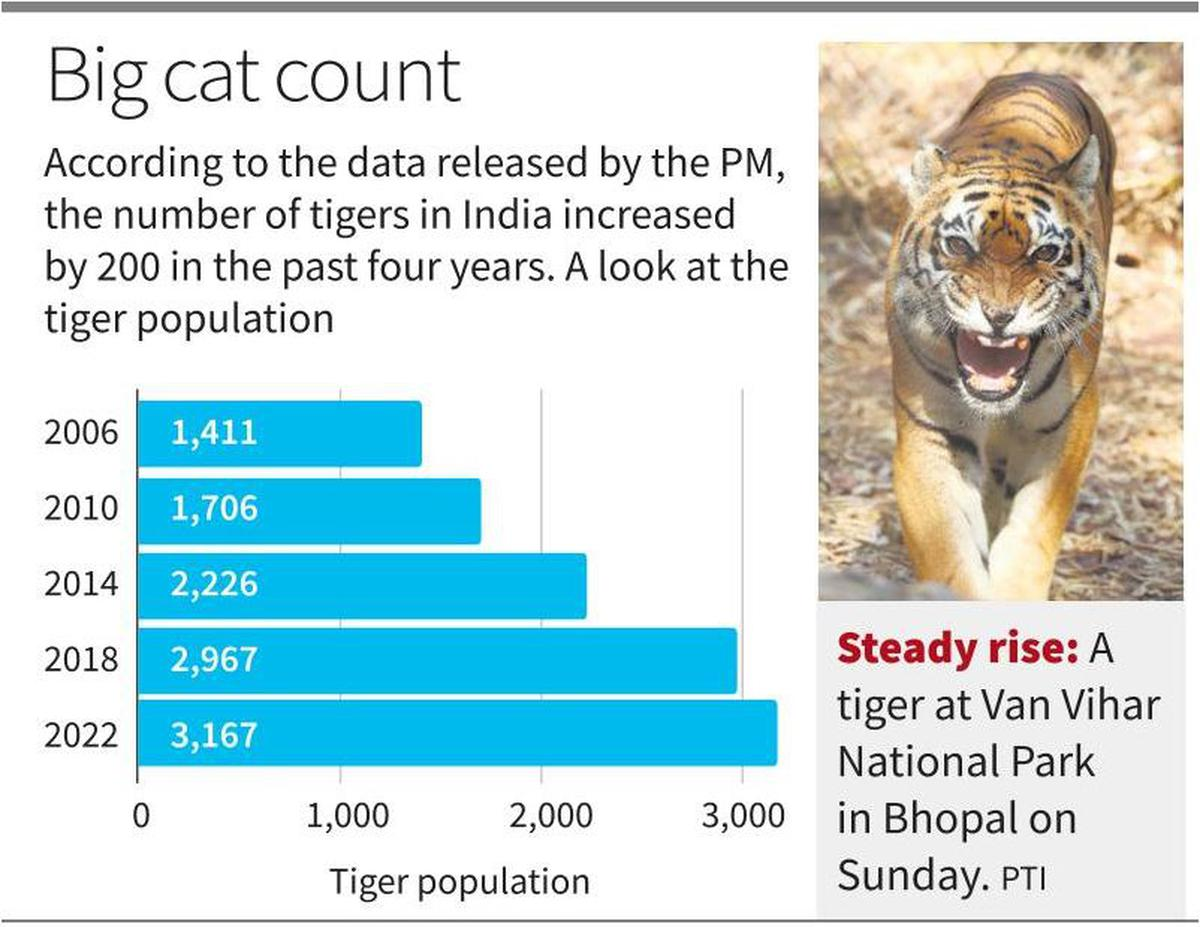Tiger Census 2022 | 11 Apr 2023
Why in News?
The Prime Minister of India has released the figures of the 5th cycle of India’s Tiger Census 2022, revealing 6.7% in the increase in the past four years.
- The tiger census covered forested habitats in 20 states of India. Camera traps were set up at 32,588 locations and generated 47,081,881 photographs.
- The PM has released the Census while inaugurating the International Big Cat Alliance (IBC) in Karnataka’s Mysuru, organised to mark 50 years of Project Tiger.
What is the IBCA?
- IBCA is launched for conservation of seven big cats namely Tiger, Lion, Leopard, Snow Leopard, Leopard, Cheetah, Jaguar and Puma harbouring our planet.
- Its members include 97 countries that are home to these big cats and other interested parties.
- The IBCA will engage in advocacy, partnerships, capacity building, eco-tourism, and finance tapping.
- It will also disseminate information and create awareness among its members.
What are the Highlights of the Census?
- Population:
- Population has grown by 200 from 2018 to 2022. The current tiger population in India is 3,167, up from 2,967 in 2018.
- Growth Rate:
- The growth rate slowed to 6.7% in the four years from 2018 to 2022, from around 33% during 2014-2018.
- Increase:
- There has been a significant increase in the tiger population in the Shivalik Hills and Gangetic Plains, while tiger occupancy in Jharkhand, Odisha, Chhattisgarh, and Telangana showed a decline.
- The North East Hills and Brahmaputra Plains had 194 tigers captured by camera traps, and the region's Nilgiri cluster is the largest tiger population in the world, contributing significantly to colonisation of tigers in neighbouring areas.
- Decline:
- Tiger occupancy in the Western Ghats declined, the latest analysis showed. Significant declines were observed in the Wayanad landscape and in the Biligiriranga Hills.
- High Conservation Priority:
- The genetically unique and small population of tigers in Simlipal is also highlighted as being of high conservation priority.
- The report calls for ecologically viable economic development and trans-boundary tiger conservation strategies to sustain isolated populations.
What is the Need for Conserving Tigers?
- Biodiversity: Tigers are an apex predator and play a vital role in maintaining the ecological balance of their habitats. They help regulate prey populations, which in turn helps maintain the balance of other species in the ecosystem.
- Tourism: Tigers are a major tourist attraction in countries like India and help generate revenue through ecotourism. This revenue can support local communities and contribute to the economy.
- Cultural Significance: Tigers are an important cultural symbol in many cultures and religions, including Hinduism and Buddhism.
- Scientific Research: Tigers are an important subject of scientific research, as they are a keystone species, and their conservation can help protect other species in their ecosystem.
- Climate Change: Tigers are an indicator species, which means that their presence or absence can indicate the health of the ecosystem. Conserving tigers can help protect the ecosystem from the effects of climate change.
Tiger Census in India
- The national tiger census is done every four years by the National Tiger Conservation Authority (NTCA) in partnership with state forest departments, conservation NGOs, and the Wildlife Institute of India (WII). The census uses a double sampling method based on ground-based surveys and images from camera-traps.
What are the Key Points Related to Tiger?
- Scientific Name: Panthera tigris
- Indian Sub Species: Panthera tigris tigris.
- Habitat:
- Its habitat stretches from Siberian temperate forests to subtropical and tropical forests on the Indian subcontinent and Sumatra.
- It is the largest cat species and a member of the genus Panthera.
- Traditionally eight subspecies of tigers have been recognized, out of which three are extinct.
- Bengal Tigers: Indian Subcontinent
- Caspian tiger: Turkey through central and west Asia (extinct).
- Amur tiger: Amur Rivers region of Russia and China, and North Korea
- Javan tiger: Java, Indonesia (extinct).
- South China tiger: South central China.
- Bali tiger: Bali, Indonesia (extinct).
- Sumatran tiger: Sumatra, Indonesia.
- Indo-Chinese tiger: Continental south-east Asia.
- Threats:
- Habitat destruction, habitat fragmentation and poaching.
- Protection Status:
- Indian Wildlife (Protection) Act, 1972: Schedule I
- International Union for Conservation of Nature (IUCN) Red List: Endangered.
- Convention on International Trade in Endangered Species of Wild Fauna and Flora (CITES): Appendix I.
- Tiger Reserves in India
- Total Number: 53 according to NTCA.
- Largest: Nagarjunsagar Srisailam Tiger Reserve, Andhra Pradesh on the basis of core area.
- Smallest: Orang tiger reserve in Assam on the basis of core area.
What are the Related Steps Taken?
- Project Tiger 1973: Project Tiger is a Centrally Sponsored Scheme of the Ministry of Environment, Forests and Climate Change (MoEFCC) launched in 1973. It provides havens for tigers in the country’s national parks.
- National Tiger Conservation Authority (NTCA): It is a statutory body under the MoEFCC and was established in 2005 following the recommendations of the Tiger Task Force. NTCA has been constituted under has been constituted under section 38 L (1) of Wildlife (Protection) Act, 1972.
- Conservation Assured | Tiger Standards: CA|TS is a set of criteria which allows tiger sites to check if their management will lead to successful tiger conservation.
UPSC Civil Services Examination, Previous Year Question (PYQ)
Q. Among the following Tiger Reserves, which one has the largest area under “Critical Tiger Habitat”? (2020)
(a) Corbett
(b) Ranthambore
(c) Nagarjunasagar-Srisailam
(d) Sundarbans
Ans: (c)
- Critical Tiger Habitats (CTH), also known as core areas of tiger reserves, are identified under the Wild Life Protection Act, 1972 based on scientific evidence that “such areas are required to be kept as inviolative for the purpose of tiger conservation, without affecting the rights of the Scheduled Tribes or such other forest dwellers”.
- The CTHs are notified by the state government in consultation with the expert committee constituted for the purpose.
- Area of the Core/Critical Tiger Habitat
- Corbett (Uttarakhand): 821.99 sq. Kms
- Ranthambore (Rajasthan): 1113.36 sq. Kms
- Sundarbans (West Bengal): 1699.62 sq. Kms
- Nagarjunsagar Srisailam (part of Andhra Pradesh): 2595.72 sq. Kms
- Therefore, option (c) is the correct answer.


